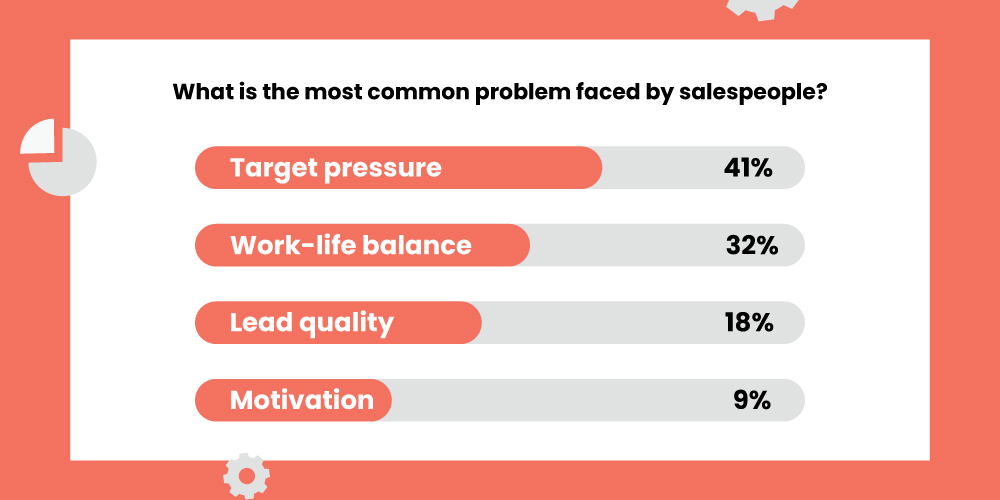With just one quarter to go, the pressure to hit sales targets is off the charts. We surveyed over 1000 salespeople and found that around 41% believe that the biggest challenge they face in sales is target pressure.

As Q3 ended, a few salespeople may have missed their targets and consequently, the incentives they hoped for.
But, the good part about sales is that we can learn from our experiences. The even better part about sales is that we can learn from the experience of others.
And that was our aim when we hosted two seasoned sales professionals at our Sales Masterclass on Crushing your Q4 targets–Arjun Mathur, Associate Director at Emeritus and Anil Kumar, Director-Sales at LeadSquared. They shared their experiences and several valuable tips on driving growth despite target pressure. With 30 years of combined sales experience between them, they’ve been in many high-pressure situations with mountain high revenue sales targets. You can watch the recording of the webinar here:
Through a poll, we found out that by the end of Q3 most of the salespeople achieve around 40% of their sales targets. Since most of the sales happen in Q4, these tips will help you achieve your yearly targets.

Do your sales targets seem unachievable?

As we spoke to salespeople, we realized that the pressure of achieving sales targets makes it hard for salespeople to even sleep at night. As a leader, it is important for you to guide your team and help them towards their target.
1. Break down the bigger milestones into smaller ones: The yearly target can look unattainable, even with a plan in hand. But once you break down the plan into smaller easily digestible chunks (weekly and daily targets), it becomes relatively easier to achieve. Tracking progress on a weekly basis also allows you to identify roadblocks and address them early. communicate it effectively to a senior manager. You should also utilise technology, (like CRM Software), to know who is performing well, who is struggling (and help them accordingly), analyse an industry’s closing trends, and track engagement in the funnel pipeline.
2. Align Sales and Marketing goals: Once both the sales and marketing teams join forces and move in the same direction, conversions increase. Usually, there is an ongoing tussle between the two teams on the quality of leads and how long conversions take. Eventually, all activities feed into overall growth, so working in collaboration benefits both teams.
3. Create a buffer: No matter how well you plan, things can go off track right at the quarter-end. A person can say no even after ten good conversations. So, it’s only wise for your team to shoot for 15-20% extra of your sales targets. This ensures that you don’t miss your targets even if a few deals go south.
4. Have goals in plain sight: Arjun gets his teams to write down their targets on a whiteboard. When a team member closes a deal, he gets the chance to go and take this amount off the total goal. This may seem small, but watching the numbers move over time is motivating, and it also serves as a great team-building exercise.
How do you deal with the pressure from senior management?

You’re accountable for your performance, and your team’s. Performing bad can mean losing out on incentives, but the dreaded discussion of “what went wrong” that you have with your manager, is much worse. To manage expectations and, to put it bluntly, avoid being yelled at by your manager, here’s what you should do:
1. Keep them in the loop: Always inform your managers about the plan that you have in mind. Keep them updated as well, which makes them a stakeholder in the process. If the numbers seem too hard, or if you falter in the process, you can ask for guidance, and they’ll understand since they’ve been an active contributor since day one.
2. Discuss the roadblocks: Anil suggests that you sit down with your team and discuss new case studies, use cases and how your sales team can handle the objections they face. Brainstorming gives us the best of ideas.
3. Map out your tasks: Stick to the basics to navigate the pressure. If you know the process and stay diligent to it, it becomes easy to meet the expectations. For example, if you know that out of ten calls, 2-3 are potentially interested, the same data can be scaled up to plan your tasks.
What are the tips that great managers swear by to help their teams grow?

Well, you’ve got people who hold you accountable as well. As a manager, the pressure multiplies because you want your entire team to do well. Over the years, Arjun also tried various managerial approaches, including The Wolf of Wall Street-inspired method, which he obviously let go of very soon. Here’s what did stick:
1. Recognise and reward the talent: Identify the star performers in the team and appreciate their drive. Offer them more responsibilities as mini managers so that they can guide the others. Honing their talents can also help them take up managerial roles in the future.
2. Team building activities:
“Something as simple as a pizza party brings the team together. Sales is competitive, which can drive team members apart, but we’re all in the same boat, so being supportive can help every individual perform better”, says Arjun.
3. Avoid micromanagement: Since we’ve gone remote, people prefer to work flexibly on their own time. It’s hard to keep a check on everyone, but as a manager, you should let your team be responsible and manage their tasks on their own. Imposing a set schedule or binding work hours can do more harm than good.
How does a team continue to crush sales targets?

A team’s performance and ability to hit targets is directly dependent on each individual’s performance. Both Anil and Arjun believe that for a team to keep meeting their sales targets, they need to hire the right talent every time. Most CEOs and leaders also think that finding the right talent is hard to do.
1. Find the right fit: Even one wrong hire delays the entire process, and there’s a waste of time and resources in the process as well. While hiring, there should be a cultural fit, and you should be able to see a future for them in your team. Communicate this to them so that they know that their effort is worth it because it’ll take them ahead in their career.
2. Standardise the training process: To bring every employee to the same page, you need to look back at your mistakes and ensure that the recruits don’t make them. For this, there can be a set of guidelines or a standard training process in place.
Anil said, “One way to do this for a sales team is to share the list of common objections and practice cold calls with new recruits.”
3. Work Smart: Another way to ensure that your teams know what they’re doing is finding the right hybrid between manual and automated tasks. To decrease the pressure on your sales team, you can choose the right Sales CRM software to handle all the tasks that take up a chunk of their time. This gives them the freedom to work on more important tasks such as talking to clients and closing deals.
These tips that Arjun and Anil shared have helped their teams grow rapidly and increase productivity. Closing Q4 can seem like a daunting task and the pressure to perform well makes it harder. With proper planning, team building, and managing your teams the right way, you can close Q4 with a bang.
Questions from the audience
With the immense competition in today’s world, what should we target apart from relationship building?
There are three things that you should focus on—Ensuring that you make the right number of calls, know the product thoroughly, and find the answers to common objections. A call turns out to be successful when you know your product’s USP and add value for your prospect.
Where should we draw the line during a B2C follow up?
Leveraging the right technology can provide you with the business intelligence needed to follow up better. While 5-10 follow ups are considered to be the right parameter, a CRM platform can help you engage them at a later stage through your marketing campaigns.
How many calls per day are ideal while prospecting for B2B?
The answer varies across industries and services, but looking back at the data works in every scenario. To calculate the number of calls you need to make before you close the deal, you can take a look at the data from the previous months to understand the trend. Analysing the quantity and quality of the calls will give you a fair estimate.
Is there a secret phrase that you use to build a strong pitch?
If the sales advisor is talking more than the person who’s looking to buy, then the deal is already lost. It’s important to understand where the person is coming from and then connect the dots. So, you need to help them understand how your product solves the challenges that they face.
Do you have any recommendations of courses or training platforms that can help us groom our sales team, especially for cold calling?
There’s no guide or course as such but your trials and even mistakes are the best teachers. For a lot of startups, this tends to be an iterative process. You should be open to failures and the process involves a lot of original thinking.
Does cold calling work for B2B?
The outreach approach works the same for both cold calling and LinkedIn. Cold calling has always worked. It can evolve over time and there are ways by which you can improve it. Such as, sounding energetic and smiling during the call.








![7 Keys to Engaging College Students with Virtual Enrollment Presentations [Webinar] 7 virtual enrollment](https://www.leadsquared.com/wp-content/uploads/2021/11/Virtual-events-80x80.jpeg)
